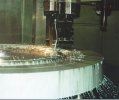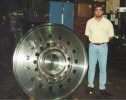A Shop's View Of Vertical Turning
Every metalworking application is different. The challenge for shops is matching the appropriate level of technology to the job at hand. Here's how one job shop uses its vertical turning machines to produce large, heavy and tough workpieces for gas turbine engine applications.
Turning is one of humankind's oldest material-working processes. Evidence of lathe working is found in Egyptian tombs and other ancient archeological sites.
Interestingly, in the past few years the process of turning in metalworking has seen some of the most dramatic innovation applied to it. Live tooling, C-axis, Y-axis, tool changers, inverted vertical spindles and more can be found on numerous machines currently available.
In some cases, the industry has been hard-pressed to define some of these new machine tools. Are they turning machines that can mill, drill and tap, or machining centers that can turn? Identity conscientious notwithstanding, many shops are successfully applying these advanced technology machines to their workpieces.
There are also many applications where what seems to be old-fashioned technology is the best means to make parts. The traditionally designed VTL (vertical turret lathe) is an example of this class of technology. While its basic form has been around awhile, the VTL hasn't stopped evolving. New versions of these machine tools incorporate many of the productive technological innovations found in horizontal turning centers.
We visited McSwain Manufacturing Corporation (Cincinnati, Ohio) to find out more about current VTL technology. This company of 135 employees has 14 VTLs ranging in size from 48 inches to 92 inches in diameter. We talked to Andy Thiemann, manufacturing engineer, about what his company looks for in vertical turning for its shop's applications.
The Application
Most of the workpieces McSwain puts across its stable of VTLs are disks of various sizes that will eventually hold turbine blades in gas turbine engines. "We supply several hundred different major components for one of the largest suppliers of gas turbine engines," says Mr. Thiemann.
Among the uses for gas turbine engines, a major one is as back up for electric power generation. As peak demand for electricity reaches ever-higher levels, U.S. power plants are looking to auxiliary power sources to handle the additional demand.
Like most turbines, functionally a gas turbine is a relatively simple machine. Fuel is burned in a combustion chamber, and the expanding gas passes through a series of blades turning them like air across a fan. Rotational speeds and temperatures are very high in these engines.
McSwain manufactures the shafts and disks used in the turbine engines. The material is chrome-moly steel. The blanks are pre-machined forgings.
An order enters the shop and is processed through as a kit. All of the relevant parts for a given gas turbine are processed through the shop at once. Scheduling demands coordination among the various machining departments to get all of the work through the shop at the same time.
Semantics—Vertical Turning/Boring
What do you call the modern VTL? The historic difference between vertical boring mills (VBM) and vertical turret lathes has become blurred. Traditionally a VBM had one or two ram-type heads that delivered a tool to the workpiece. An indexable tool turret head distinguished traditional VTLs from VBMs.
Aside from turret head or ram head, both machine designs use a rotating table to support the workpiece and use a bridge-type construction that carries the X axis. A ram traverses the X-axis guides and delivers the cutter.
Numerous modern machine designs combine turrets with rams, and some have a boring ram mounted alongside a turret head. The traditional distinction between the two types has become meaningless.
What To Look For
An important advantage of the VTL machine is the ease in which large heavy workpieces can be set and held in place for machining. An advantage to any shop using VTL is that gravity is an important factor in holding these parts. Generally only a minimum of hard clamping is required. McSwain has workpiece blanks weighing as much as 22,000 lbs.
"We can hold the work in place using relatively light clamping," says Mr. Thiemann. "This is preferred for our applications where clamping too hard could induce warpage in the turbine disks. We do not use plain-face top-jaw tables on our machines because of the runout requirements of our workpieces. Instead we were able to get independent four jaw tables on the Olympia machines."
Like many shops looking for large turning capacity, McSwain has in the past gone to the used machine market. Rebuilt and remanufactured VTLs can be a good value.
More recently, though, the company has begun purchasing new machines. Most of these have been from Olympia Engineering, Ltd. (Toronto, Canada).
According to Mr. Thiemann, "prices for new VTLs have become competitive with some used and rebuilt machines. Some of this has been caused by the economic problems in Asia. Also the collapse of the Soviet Union has made castings and other base materials available to builders at highly reduced rates. Both of these factors have contributed to lower prices for this class of machine tool."
Buying components inexpensively is not sufficient to make a good machine, however. Design considerations that McSwain looks for are, of course, in line with the company's requirements for turning turbine disks and other major components for gas turbine engines.
"The ram is generally the weakest link in the VTL design," says Mr. Thiemann. "Rigidity of the ram is a critical consideration for our shop because of the amount of metal we remove from the forging blank. Heavy cuts, especially in tough material, will quickly expose structural weaknesses in the machine tool."
Obviously the ratio of ram deflection to its extension is a key indicator of the cutting ability of a machine. In operation, lowering the cross rail so the ram is extended only as far as necessary to reach the workpiece can minimize the extension of the ram.
Cutting forces of 11,000 lbs can be generated on the Olympia VTLs. McSwain is able to hold the tolerance of these large workpieces to ±0.0005 inch on the diameter with no material conditioning.
Runout requirements for the disks are 0.0005 inch from primary to secondary operations. The overall finish requirement for the various families of workpieces is 32 RMS.
For McSwain's disk turning application, Mr. Thiemann likes the half-rail design of the Olympia. "Rigidity is also enhanced by use of a half-travel rail system," he says. "Instead of building the ways across the full width of the cross rail, so that X-axis zero is in the middle of the cross rail, on the half-travel system the ram carrier extends only about 100 mm past the table centerline. This concentrates the mass of the structure and allows use of shorter ballscrews."
The downside of a half travel rail system is that it requires use of both left- and right-hand tooling. "That's not a problem for us," says Mr. Thiemann, "because our machines have 12 station tool changers. Due to the long cycle times, the ratio of cutting time to tool change time is inconsequential."
Appropriate Technology
One of the more challenging aspects of the metalworking is the variety of technology available. For many applications in metalworking, a CNC-equipped VTL with tool changer is viable technology.
McSwain, of course, uses that technology successfully. The company is also in the forefront of technology on another important side of its business, small workpiece manufacturing.
Among the technologies applied on this side of the business are four Mazak Palletech cells that process aluminum castings for the aerospace and information technology industries. "These are high speed machining cells," says Mr. Thiemann, "designed for high mix, medium volume production of high precision parts."
At this shop, up-to-date classic turning technology meets what many consider state-of-the-art manufacturing all under one roof. As with so much of the technology available to shops, the art of metalworking is matching the right technological science to the job you have to do. McSwain represents a good example of this idea in practice.
Related Content
Romi Launches Flatbed Lathe for Machining Large Parts
The C 1100H is a heavy-duty flatbed lathe built with a monoblock cast iron bed that absorbs machining efforts and vibration, making it highly rigid, stable and accurate.
Read MoreKaast Machine Tools Updates Dual-Spindle Lathe
The A-Turn SYMCNC Dual-Spindle Lathe is now available in four different swing lengths, including 22.5", 24", 26.75" or 36".
Read MoreQuick-Change Tool Heads Reduce Setup on Swiss-Type Turning Centers
This new quick-change tooling system enables shops to get more production from their Swiss turning centers through reduced tool setup time and matches the performance of a solid tool.
Read MoreCNC Machine Shop Honored for Automation, Machine Monitoring
From cobots to machine monitoring, this Top Shop honoree shows that machining technology is about more than the machine tool.
Read MoreRead Next
3 Mistakes That Cause CNC Programs to Fail
Despite enhancements to manufacturing technology, there are still issues today that can cause programs to fail. These failures can cause lost time, scrapped parts, damaged machines and even injured operators.
Read MoreThe Cut Scene: The Finer Details of Large-Format Machining
Small details and features can have an outsized impact on large parts, such as Barbco’s collapsible utility drill head.
Read More.jpg;maxWidth=970;quality=90)













.jpg;maxWidth=300;quality=90)












.png;maxWidth=300;quality=90)









.jpg;maxWidth=970;quality=90)